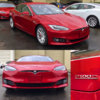Let me refine my comment that I don't think you are using weight PROPERLY, then.
Also, the way you present your calculations make it extremely hard to follow. It also looks like you add in a bunch of additional ET datapoints which seem unnecessary. Given that the ET is a variable it seems foolish to try to run calculations with it and expect a precise output.
Power/Weight Ratio is the single biggest factor in Drag. The next largest is traction, then there are a bunch of factors that are essentially not measureable. Given that the only major difference between all Model S XxxD cars is power and weight we can generally ignore the remaining variables. We can get a reasonable idea on traction based on 60' times which would allow us to estimate a margin of error.
Would it not be a LOT easier to simply plot Power/Weight ratio on the X axis, ET on the Y axis and add in all the datapoints we have and form a trend line?



